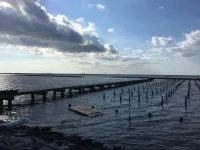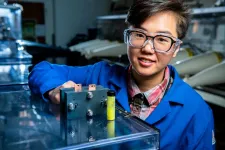(Press-News.org) Flies predict changes in their visual environment in order to execute evasive maneuvers, according to new research from the University of Chicago. This reliance on predictive information to guide behavior suggests that prediction may be a general feature of animal nervous systems in supporting quick behavioral changes. The study was published on May 20 in PLOS Computational Biology.
Animals use their sensory nervous systems to take in information about their environments and then carry out certain behaviors in response to what they detect. However, the nervous system takes time to process this sensory information, meaning that the environment can change by the time the previous information has been fully processed.
"This is really important in predator/prey interactions," said senior author Stephanie Palmer, PhD, Associate Professor of Organismal Biology and Anatomy at UChicago. "For a fly, everything is trying to eat you, and you want to avoid being eaten. However, the fly's environment is rapidly changing, and the neurons they have are laggy. We wanted to study how flies were able to execute quick evasive behaviors to avoid being eaten by predators when ongoing feedback from their sensory systems hasn't been processed."
To answer this question, the investigators took a highly interdisciplinary approach. "This is a project born out of this new era of open science sharing," Palmer said. "We were able to take the precise behavioral recordings made by another group and use them for a theoretical, computational neuroscience question: Does the fly's visual system make predictions using the initial detection of a threat that can span the lag time in processing of additional feedback as the fly starts its evasive behavior?"
Previous work from first author Siwei Wang, PhD, a postdoctoral researcher in Palmer's group, looked at a theoretical model of how encoding motion in the fly visual system might work. "I had an idea of how to extend these ideas to prediction, and this study allowed me to compare my model to real life behavioral data to test my theory," Wang said.
Using detailed diagrams of the connectivity between neurons in the fly visual system, the researchers made a simulation of the visual response as they fed in the previously recorded behavioral data set. "We compared what an optimal prediction would look like and what the fly's prediction looks like, and then we broke open the simulation to try to identify which parts were the most important for making these predictions," Palmer said.
The authors first identified that sensory data about the fly's visual world passes though an information bottleneck, where some of the sensory data is thrown out by the fly's brain because it simply does not have enough computing power to handle the amount of information it is taking in. However, the fly cannot indiscriminately discard visual information, because some of it might be useful for making predictions.
The authors identified structures called axonal gap junctions, which are physical channels connecting the neurons, that mediate an optimal form of this information bottleneck and are critical for both filtering out the unnecessary information and preserving the necessary information to make predictions.
The investigators further found that a subpopulation of these vertical motion sensory neurons that are involved in making predictions is unique in that it is also directly connected to the fly's flight steering neurons. This suggests that there is direct input from the neurons responsible for making predictions about the fly's environment to neurons that control the fly's behavior. This direct connection might explain how predictions that the fly is making are able to quickly influence its behavior.
Identification of these structures and the ability of the fly visual system to make predictions is likely to drive insight into how other animals' nervous systems make similar predictions.
"Cracking open the black box of how the fly does this has revealed what we think are universal design principles that the nervous systems of other animals probably also use," Palmer said. "We're interested in searching for another example of prediction-guiding behavior in another animal and asking if what we found in the fly really does apply broadly across species."
Ultimately, this kind of theoretical neuroscience may shed light on how our human brains function. "One of our greatest challenges as humans is understanding how everything inside our head works. Insights from work on flies can be generalizable and actually give us clues to how our brains operate," Palmer said.
Wang said the results could even have implications for understanding neurodegenerative diseases like Alzheimer's disease, where the brain loses the ability to make predictions. If the insights gained from these fly studies hold true in humans, it could help uncover new specific targets for therapeutic intervention. "We're still a long way from that, but this research in flies is setting the ground work to allow others to do that down the line," Wang said.
INFORMATION:
The study, "Maximally efficient prediction in the early fly visual system may support evasive behaviors," was funded by the Gatsby Charitable Foundation, the Max Planck Hebrew University Center for Sensory Processing of the Brain in Action, the National Science Foundation CAREER Award 1652617 and Center for the Physics of Biological Function (PHY-1734030), and the National Institutes of Health grant R01EB026943. Additional authors include Idan Segev of the Hebrew University of Jerusalem and Alexander Borst of the Max Planck Institute of Neurobiology.
About the University of Chicago Medicine & Biological Sciences
The University of Chicago Medicine, with a history dating back to 1927, is one of the nation's leading academic health systems. It unites the missions of the University of Chicago Medical Center, Pritzker School of Medicine and the Biological Sciences Division. Twelve Nobel Prize winners in physiology or medicine have been affiliated with the University of Chicago Medicine. Its main Hyde Park campus is home to the Center for Care and Discovery, Bernard Mitchell Hospital, Comer Children's Hospital and the Duchossois Center for Advanced Medicine. It also has ambulatory facilities in Orland Park, South Loop and River East as well as affiliations and partnerships that create a regional network of care. UChicago Medicine offers a full range of specialty-care services for adults and children through more than 40 institutes and centers including an NCI-designated Comprehensive Cancer Center. Together with Harvey-based Ingalls Memorial, UChicago Medicine has 1,296 licensed beds, nearly 1,300 attending physicians, over 2,800 nurses and about 970 residents and fellows.
Visit UChicago Medicine's health and science news blog at http://www.uchicagomedicine.org/forefront.
Twitter @UChicagoMed
Facebook.com/UChicagoMed
Facebook.com/UChicagoMedComer
The immune system is a complex balancing act; if it overreacts or underreacts to foreign molecules, there can be serious health consequences.
For cancer patients, tumor progression is often accompanied by immunosuppression, meaning their bodies can't fight off pathogens the way they should. By contrast, for people with autoimmune diseases like type 1 diabetes, rheumatoid arthritis, and multiple sclerosis, their immune systems overreact and attack the body itself.
Both of these reactions are influenced by a series of molecular checkpoints found in both immune cells and cancer cells. In immune ...
Oysters live and grow in saltwater. However, the saltiness of their habitat can change dramatically, especially where the mighty Mississippi River flows into the Gulf of Mexico. Louisiana oysters from the northern Gulf of Mexico may experience some of the lowest salinity in the world due to the influx of fresh water from the Mississippi River. In addition, increased rainfall and large-scale river diversions for coastal protection will bring more fresh water that does not bode well for the eastern oyster. New research led by Louisiana State University (LSU) alumna Joanna Griffiths from Portland, Oregon, and her faculty advisor ...
ROCHESTER, Minn. -- You might be older - or younger - than you think. A new study found that differences between a person's age in years and his or her biological age, as predicted by an artificial intelligence (AI)-enabled EKG, can provide measurable insights into health and longevity.
The AI model accurately predicted the age of most subjects, with a mean age gap of 0.88 years between EKG age and actual age. However, a number of subjects had a gap that was much larger, either seemingly much older or much younger by EKG age.
The likelihood to die during follow-up was much ...
During the pandemic, the old waiting room phrase "the doctor will see you now" has taken on a new meaning. So has the waiting room. Our kitchen table or living room couch is where many people do work lately, and that includes visits to the doctor. New research from Syracuse University's Falk College indicates this method of health care will continue even after COVID numbers are (hopefully) reduced.
"I was surprised by the results," said the study's lead author Bhavneet Walia, assistant professor of public health at Syracuse University. "I initially thought that, because of the challenges of telehealth, physicians would not be in favor of continuing post-pandemic. It turns out they do. But ...
Researchers have long been interested in finding ways to use simple hydrocarbons, chemicals made of a small number of carbon and hydrogen atoms, to create value-added chemicals, ones used in fuels, plastics, and other complex materials. Methane, a major component of natural gas, is one such chemical that scientists would like to find to ways to use more effectively, since there is currently no environmentally friendly and large-scale way to utilize this potent greenhouse gas.
A new paper in Science provides an updated understanding of how to add functional groups onto simple hydrocarbons like methane. Conducted by graduate students Qiaomu Yang and Yusen Qiao, postdoc Yu Heng Wang, and led by professors Patrick J. Walsh and Eric J. Schelter, this new and highly detailed mechanism ...
HOUSTON - (May 20, 2021) - It's always good when your hard work reflects well on you.
With the discovery of the giant polarization rotation of light, that is literally so.
The ultrathin, highly aligned carbon nanotube films first made by Rice University physicist Junichiro Kono and his students a few years ago turned out to have a surprising phenomenon waiting within: an ability to make highly capable terahertz polarization rotation possible.
This rotation doesn't mean the films are spinning. It does mean that polarized light from a laser or other source can now be manipulated in ways that were previously out of reach, making it completely visible or completely opaque with a device that's extremely ...
At the start of the COVID-19 outbreak, a University of Illinois Chicago researcher conducted a survey asking respondents if they experienced health care delays because of the pandemic. In addition to learning about the types of delays, the study also presented a unique opportunity to capture a historic moment at the pandemic's beginning.
Elizabeth Papautsky, UIC assistant professor of biomedical and health information sciences, is first author on "Characterizing Healthcare Delays and Interruptions in the U.S. During the COVID-19 Pandemic Using Data from an Internet-Based Cross-Sectional ...
During the first phase of the COVID-19 epidemic, New York City experienced high prevalence compared to other U.S. cities, yet little is known about the circulation of SARS-CoV-2 within and among its boroughs. A study published in PLOS Pathogens by Simon Dellicour at Université Libre de Bruxelles, Belgium, Ralf Duerr and Adriana Heguy at New York University, USA, and colleagues describe the dispersal dynamics of COVID-19 viral lineages at the state and city levels, illustrating the relatively important role of the borough of Queens as a SARS-CoV-2 transmission hub.
To better understand how the virus dispersed throughout New York ...
Ancient pollen samples and a new statistical approach may shed light on the global rate of change of vegetation and eventually on how much climate change and humans have played a part in altering landscapes, according to an international team of researchers.
"We know that climate and people interact with natural ecosystems and change them," said Sarah Ivory, assistant professor of geosciences and associate in the Earth and Environmental Systems Institute, Penn State. "Typically, we go to some particular location and study this by teasing apart these influences. In particular, we know that the impact people have goes back much earlier than what is typically ...
A compound used widely in candles offers promise for a much more modern energy challenge--storing massive amounts of energy to be fed into the electric grid as the need arises.
Scientists at the U.S. Department of Energy's Pacific Northwest National Laboratory have shown that low-cost organic compounds hold promise for storing grid energy. Common fluorenone, a bright yellow powder, was at first a reluctant participant, but with enough chemical persuasion has proven to be a potent partner for energy storage in flow battery systems, large systems that store energy for the grid.
Development of such storage is critical. When the grid goes offline due to severe weather, for instance, the large batteries under ...







